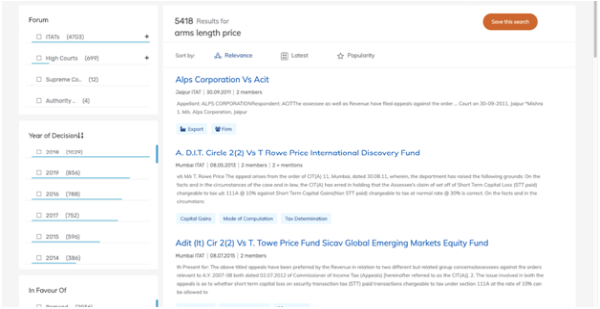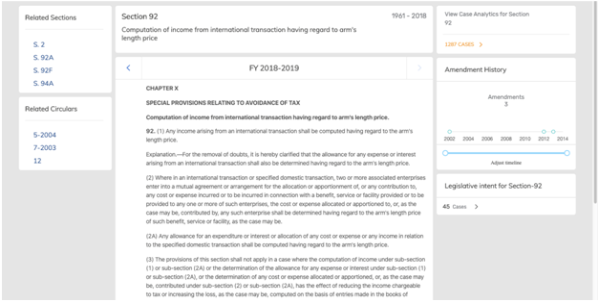Multinational enterprises tend to allocate profits in various jurisdictions by controlling prices in intra-group transactions. Intra-group transactions occur between associated enterprises or member companies belonging to the same single corporate group. This led to the need to regulate prices at which goods and services are transferred inter se among companies belonging to the same corporate group. In India, Sections 92 and 92A to 92F lay down detailed provisions pertaining to transfer pricing.

Get entire analysis of section 92 by signing up for free with Riverus.
Transfer pricing is the pricing between associated enterprises for any goods supplied or services rendered inter se. Sections 92 states that any income arising from an international transaction shall be computed on the basis of arm's length price. This principle has now also been extended to specified domestic transactions not exceeding INR 50 Crores in value. This means that prices of any goods, service or benefit availed by two associated enterprises while conducting an inter se international transaction or a specified domestic transaction shall be determined with regard to the arm's length pricing mechanism. Sections 92A to 92F discuss all the concepts pertaining to transfer pricing in extensive detail. These provisions explain the concepts of `associated enterprise', 'international transactions' and 'arm's length pricing'. We shall discuss transfer pricing provisions in India and the associated issues through a two-part blog series. In this post (Part-I), we shall be discussing the aforementioned concepts, while in the subsequent post (Part-II), we shall bring to you an analysis of the various issues associated with transfer pricing in India and the judicial position on the same.
1. Associated Enterprise
Section 92A (1) sets two primary parameters of assessing whether two entities are associated enterprises: a) Direct/indirect participation in the management, control or capital of an enterprise by another enterprise b) Same person participates directly or indirectly in the management, control or capital of both the enterprises. Apart from the aforementioned situations, there are certain circumstances upon whose occurrence, two entities are deemed to be associated enterprises. These are:
a) Direct/indirect holding of 26% or more voting power.
b) Advancing a loan which exceeds 51% of the book value of the borrowing enterprise.
c) Guarantee by an enterprise of 10% or more borrowings of another enterprise.
d) Appointment of more than 50% of board of directors of an enterprise by the other enterprise or appointment of one or more executive directors.
e) Absolute dependence of an enterprise on the intellectual property licensed to it by the other enterprise.
f) Substantial purchase or sale of raw materials/manufactured goods by an enterprise to/from another enterprise with the prices majorly influenced by the latter.
g) Existence of relationship of mutual interest.
2. International Transactions
Section 92B of the Income Tax Act defines an `international transaction' as a transaction between two or more associated enterprises, either or both of whom are non-residents. Such transaction would involve purchase, sale or lease of intangible property or provision of services, lending/borrowing money or any other transaction having an impact on the profit, income, losses or assets of such enterprise. A transaction between an associated enterprise and a third-party shall be considered to be an international transaction if a prior agreement exists in context of the relevant transaction or the terms of the relevant transaction are determined in substance between the third party and the associated enterprise. A list of transactions qualifying as international transactions has been appended to Section 92B . These inter alia include, the purchase, sale, transfer, lease or use of tangible property, the purchase, sale, transfer, lease or use of intangible property, capital financing, provision of services etc.An explanation defining intangible property has also been appended to Section 92B . Intangible property inter alia includes marketing related intangible assets such as trademarks, trade names etc.; technology related intangible assets such as patents, artistic related intangible assets, engineering related intangible assets and customer related intangible assets. The inclusion of intangible assets has given rise to many issues such as classification of brand promotion and advertising expenses inter se group companies as international transaction. We shall discuss these issues in our subsequent post.
3. Arm's Length Pricing (ALP)
Section 92F defines ALP as, a price that is applied or proposed to be applied to transactions between persons other than associated enterprises in uncontrolled conditions. Uncontrolled conditions signify a transaction between two entities which are not associated enterprises. Section 92C enumerates certain methods by which the ALP may be calculated. These include:
• Resale Price Method.
• Cost Plus Method
• Profit Split Method.
• Transactional Net Margin Method.
• Other Method
No particular method is termed as the most appropriate method and any of the given methods may be chosen. However, Rule 10C of the Income Tax Rules enumerates certain factors which helps the taxpayers choose the most appropriate method to arrive at an ALP. Some of these factors inter alia include functional analysis, availability of reliable information, degree of comparability between controlled and uncontrolled transactions etc. Other method is determined by taking into account the price which has been charged or paid or would have been charged or paid for a similar uncontrolled transaction between two entities which are not associated enterprises. If more than one price is determined an arithmetic mean of these prices is used as the arm's length price. A range benefit of 3% is granted to taxpayers. This means that if the actual pricing does not vary from the arm's length pricing by more than 3%, then the actual price can be accepted as the ALP.
In this context, it is pertinent to discuss the Safe Harbour Rules whose amended version was issued by the Central Board of Direct Taxes in 2017. Safe harbor means circumstances under which the tax authorities will accept the transfer price declared by the taxpayer. These rules provide the minimum operating profit margins in relation to the operating expenses which typically entities are expected to earn in international transactions. The revised Safe Harbour Rules apply up to Financial Year 2020. Key changes brought about were:
• Safe harbor rates for IT industry was brought down to 17-18%.
• Upper turnover threshold of INR 200 Crores was introduced.
Access 5000+ cases on arm's length price by signing up with Riverus for free:

Documentation
Section 92D read with Rule 10D mandate taxpayers to maintain on an annual basis extensive sets of documentation involved in conducting international transactions or specified domestic transactions. Some mandatory documents required to be maintained inter alia include information on ownership structure of the taxpayer, group profile, business overview of the taxpayer etc. The taxpayer is also required to conduct a comprehensive transfer pricing study of the alleged transaction. Taxpayers having transactions below the prescribed monetary threshold of INR 10 million for international transactions and INR 5 Crores for domestic transactions are not subject to documentation requirements. Additionally, it is required of all taxpayers, to get an independent accountant's report in respect of all international transactions between associated enterprises or specified domestic transactions.
Conclusion
Transfer Pricing laws help in preventing profit allocation in different jurisdictions by multinational enterprises. However, having a wide set of rules, throws up myriad issues. A number of issues have arisen with respect to the interpretation and application of these concepts, which we shall be discussing in our subsequent post.
Written by Soumya Shekhar, legal writer @ Riverus
----------------------------------------------------------------------------------------------------
Riverus is a legal research and analytics tool for income tax. We use modern technologies like machine learning to make your research experience fast and efficient. Using analytics, you can discover insights, construct a strategy, and mitigate risks.
 The product enables tax professionals to draw valuable insight and information from more than 4 lakhs judgments and orders(reported + unreported) given by courts and tribunals.
The product enables tax professionals to draw valuable insight and information from more than 4 lakhs judgments and orders(reported + unreported) given by courts and tribunals.
Many accountants and lawyers in western countries use machine learning powered research tools today. It helps them provide better service, and build a more satisfied customer base. Not to mention the efficiency and time savings it brings in. Now, with Riverus, such technology is at your beck and call and you can use it to win more customers and delight the existing ones.










 CAclubindia
CAclubindia
